
Semi Electric vs Electric Hospital Bed: Which Is Better for Stroke Recovery?
📋 KEY TAKEAWAYS
| Feature | Semi-Electric Hospital Beds | Full-Electric Hospital Beds |
|---|---|---|
| Price Range | $1,000-$1,800 | $1,200-$3,500+ |
| Head/Foot Adjustment | Electric (remote control) | Electric (remote control) |
| Height Adjustment | Manual crank | Electric (remote control) |
| Patient Independence | Moderate (requires help for height) | High (controls all functions) |
| Caregiver Strain | Moderate (manual cranking) | Low (all functions electric) |
| Stroke Recovery Support | Good (position adjustment) | Excellent (complete positioning) |
| Medicare Coverage | Yes (when prescribed) | Yes (when prescribed) |
Best for Most Stroke Patients: Costcare Full Electric Hospital Bed B135C – Complete positioning control ideal for recovery
Budget Option: Costcare Semi-Electric Bed B120C – Affordable with essential head/foot electric functions
For Limited Mobility: Ultra Low Hospital Bed Medacure ULB3.9 – Safest option with ultra-low height capability
Semi electric vs electric hospital bed choices can significantly impact the quality and speed of stroke recovery at home. While both bed types offer essential adjustability for positioning stroke patients, they differ in operation, convenience, and suitability for various recovery stages. Making the right choice can enhance rehabilitation outcomes, improve comfort, and reduce caregiver strain during this critical recovery period.
After thorough evaluation of both options for stroke recovery specifically, the Costcare Full Electric Hospital Bed B135C emerges as the superior choice for most stroke patients. Its complete electric functionality provides the independent positioning control and height adjustability that supports optimal rehabilitation while reducing caregiver burden throughout the recovery journey.
In this comprehensive guide, we'll examine how both semi-electric and full-electric hospital beds address specific stroke recovery challenges, helping you determine which option best suits your particular situation and recovery needs.
Fundamental Differences Between Semi-Electric and Electric Hospital Beds
Understanding the basic operational differences between these two hospital bed types is essential for making an informed decision for stroke recovery.
| Feature | Semi-Electric Hospital Beds | Full-Electric Hospital Beds |
|---|---|---|
| Head/Foot Adjustment | Electric motors with remote control | Electric motors with remote control |
| Height Adjustment | Manual crank system | Electric motor with remote control |
| Operation Requirements | Remote + physical cranking | Remote control only |
| Price Range | $1,000-$1,800 | $1,200-$3,500+ |
| Power Outage Function | Manual height adjustment works without power | Battery backup needed for function during outages |
| Maintenance Needs | Moderate (mechanical + electrical) | Lower (primarily electrical) |
Semi-Electric Hospital Beds: Design and Functionality
Semi-electric hospital beds represent a hybrid approach, combining electric motors for some functions with manual operation for others.
Key characteristics of semi-electric beds include:
- Partially electric operation: Electric motors control head and foot positioning via remote control
- Manual height adjustment: Hand crank required to raise or lower the entire bed frame
- Moderate price point: Less expensive than full-electric models
- Split control system: Electronic remote for position, manual crank for height
- Crank location: Typically foot-end mounted, requiring physical access to operate
The Costcare Semi-Electric Bed B120C at $1,068 exemplifies this design, featuring electric head and foot adjustments with a manual height crank system.
Advantages for stroke recovery:
- More affordable option for essential positioning
- Continues to function partially during power outages
- Fewer electrical components that could fail
- Simpler mechanical system for some functions
- Lower initial investment for temporary recovery
Limitations for stroke recovery:
- Height adjustment requires physical effort
- Caregiver must be present for bed height changes
- Less independent operation for patients
- More labor-intensive for frequent height adjustments
- Height crank may be difficult to access in some room arrangements
Full-Electric Hospital Beds: Design and Functionality
Full-electric hospital beds utilize motors for all adjustable functions, offering complete electronic control.
Key characteristics of full-electric beds include:
- Completely motorized: Electric motors control all bed functions
- Comprehensive remote: Single control device manages head, foot, and height positions
- Higher price point: More expensive than semi-electric models
- Multiple control options: Often feature separate patient and caregiver controls
- Advanced positioning: Some models offer preset positions and memory functions
The Icare Adjustable Electric Home Hospital Bed - IC333 at $3,200 represents a premium full-electric option with comprehensive electronic control.
Advantages for stroke recovery:
- Complete independence for patients who can use remote
- Effortless height adjustment for transfers and caregiving
- Reduced physical strain on caregivers
- One-touch operation for all functions
- Precise positioning capability for therapy needs
Limitations for stroke recovery:
- Higher initial cost
- Reliance on electrical power (though many have battery backups)
- More complex electrical systems to maintain
- Potential for motor failure with intensive use
- May require professional service for repairs
Stroke Recovery Requirements and Bed Features
Stroke recovery presents specific challenges that hospital beds must address. Understanding these requirements helps determine which bed type better serves patients during rehabilitation.
Position Adjustments for Stroke Rehabilitation
Proper positioning is critical during stroke recovery to prevent complications and support rehabilitation.
Common positioning needs for stroke patients:
- Elevated head position: Reduces aspiration risk and helps with swallowing difficulties
- Variable inclines: Supports different therapy activities throughout the day
- Pressure redistribution: Prevents pressure ulcers during periods of limited mobility
- Side-lying positioning: Facilitates proper alignment and comfort
- Elevation for circulation: Helps manage edema in affected limbs
The Trendelenburg Costcare Adjustable Medical Bed B337 at $1,675 offers specialized therapeutic positioning capabilities beneficial for stroke rehabilitation.
Semi-electric beds provide:
- Electric head and foot adjustment for essential positioning
- Adequate support for basic rehabilitation exercises
- Sufficient incline options for aspiration prevention
- Required positions for most therapy activities
- Manual backup during power outages
Full-electric beds offer advantages through:
- One-touch positioning changes by the patient themselves
- More precise angle adjustments for specialized therapy
- Easier transitions between multiple therapy positions
- Height adjustability for transfer safety
- Reduced caregiver strain during position changes
Mobility Support and Transfer Safety
Bed transfers represent one of the most challenging and potentially dangerous activities during stroke recovery.
Critical transfer considerations for stroke patients:
- Height adjustment: Essential for safe transfers to standing or wheelchair
- Stability during transfers: Preventing bed movement when patient is shifting weight
- Side rail support: Providing secure grip points for movement
- Caregiver access: Allowing proper body mechanics during assistance
- Fall prevention: Minimizing distance to floor when necessary
The Ultra Low Hospital Bed Medacure ULB3.9 at $2,240-$2,440 features an extremely low 3.9" minimum height, making it exceptionally safe for stroke patients with fall risks.
Semi-electric beds present challenges:
- Manual cranking required before each transfer
- Physical effort needed from caregiver
- Time-consuming adjustment process
- Potential for improper height if rushed
- Increased risk during emergency situations
Full-electric beds excel through:
- One-touch height adjustment to precise transfer positions
- Quick changes for emergency situations
- Customizable height for different transfer techniques
- Reduced physical strain on caregivers
- Independent height control by capable patients
Independence and Patient Control During Recovery
Recovery from stroke often involves a progressive return to independence, making patient control of the environment important.
Independence considerations during stroke recovery:
- Control accessibility: Can the patient operate necessary functions?
- Effort required: Physical capability needed to make adjustments
- Position versatility: Options for comfort throughout the day
- Self-management: Ability to change positions without assistance
- Progressive adaptation: Supports increasing independence during recovery
The Costcare Full Electric Hospital Bed B135C at $1,298 provides full electronic control, supporting greater independence during the recovery process.
Semi-electric beds limit independence through:
- Reliance on others for height adjustment
- Inability to manage all functions independently
- Required physical capability for cranking
- Potential frustration with partial control
- Limited adaptation to increasing independence
Full-electric beds support independence through:
- Complete control via single remote device
- No physical strength required for adjustments
- Ability to adjust all positions independently
- Support for self-management of comfort
- Adaptation to various recovery stages
Caregiver Considerations for Stroke Patient Care
The impact on caregivers is a crucial factor when selecting a hospital bed for stroke recovery, as their wellness directly affects care quality.
| Caregiver Factor | Semi-Electric Impact | Full-Electric Impact |
|---|---|---|
| Physical Strain | Higher (manual cranking) | Lower (all motorized functions) |
| Time Requirements | More time for adjustments | Quicker adjustments |
| Assistance Frequency | Higher (for height changes) | Lower (patient can control) |
| Ergonomic Positioning | Limited by fixed height | Optimized with height control |
| Nighttime Disruptions | More frequent disruptions | Reduced need for assistance |
Physical Demands and Caregiver Strain
Caregiver physical wellbeing directly impacts their ability to provide consistent care throughout stroke recovery.
Physical demands during stroke patient care:
- Position adjustments: Frequent changes throughout the day for comfort and therapy
- Transfer assistance: Supporting patient movement in/out of bed
- Bed height changes: Adjusting for transfers, care, and comfort
- Extended care duration: Stroke recovery often spans months
- Repetitive tasks: Same adjustments required multiple times daily
The TransferMaster Full Electric Hi-Lo Hospital Bed Supernal 3 starting at $3,441 offers exceptional ergonomic support for caregivers through its comprehensive electronic positioning.
Semi-electric beds impact caregivers through:
- Manual cranking requiring physical effort
- Bending and reaching to operate height crank
- Repetitive motion strain from frequent adjustments
- Time spent on mechanical operations
- Risk of back injury during cranking
Full-electric beds benefit caregivers through:
- Elimination of physical cranking effort
- Optimal working height for all care activities
- Reduced bending and reaching
- Prevention of cumulative strain injuries
- Energy conservation for essential care tasks
Time Management and Care Efficiency
Time efficiency becomes particularly important when caring for stroke patients with multiple daily care requirements.
Time factors in stroke recovery care:
- Adjustment frequency: Multiple position changes throughout the day
- Transfer preparation: Bed setup before each transfer event
- Therapy support: Positioning for various rehabilitation activities
- Emergency response: Quick adjustments when needed
- Night care: Managing nighttime needs efficiently
The Medacure Split Frame LX-BARI Adjustable Bariatric Electric Hospital Bed at $2,558 features efficient electronic controls for all functions, saving valuable caregiver time.
Semi-electric beds affect time management through:
- Longer process for each height adjustment
- Increased time spent on mechanical operations
- More frequent caregiver involvement required
- Extended preparation for transfers
- Inability to make quick height changes
Full-electric beds improve efficiency through:
- Immediate height adjustments
- One-touch operation for all functions
- Reduced time spent on bed mechanics
- Quick response to changing needs
- Less caregiver involvement for basic adjustments
Long-Term Sustainability of Care
Stroke recovery often extends over months or years, making sustainable care arrangements essential.
Long-term care sustainability factors:
- Caregiver health preservation: Preventing injury and burnout
- Care consistency: Maintaining quality over extended periods
- Adaptation to changing needs: Supporting evolving recovery stages
- Multiple caregiver support: Accommodating different caregivers
- Patient-caregiver relationship: Focusing on rehabilitation rather than mechanics
Semi-electric beds present sustainability challenges:
- Cumulative physical strain over time
- Potential for caregiver injury or burnout
- Limited adaptability as recovery progresses
- Continued dependence for height adjustments
- Greater focus on mechanical tasks vs. rehabilitation
Full-electric beds support sustainable care through:
- Prevention of caregiver physical strain
- Reduced risk of care interruption due to caregiver injury
- Better adaptation to progressive recovery stages
- Easier use by multiple or rotating caregivers
- More time and energy focused on rehabilitation
Specific Recovery Phases and Bed Type Suitability
Stroke recovery typically progresses through distinct phases, each with different bed functionality requirements.
| Recovery Phase | Semi-Electric Suitability | Full-Electric Suitability |
|---|---|---|
| Acute Recovery (1-4 weeks) | Moderate (high caregiver involvement) | Excellent (reduces strain during intensive care) |
| Early Rehabilitation (1-3 months) | Moderate (frequent position changes) | Excellent (supports therapy positioning) |
| Advanced Rehabilitation (3+ months) | Good (more patient independence) | Excellent (facilitates progressive independence) |
| Long-term Recovery (6+ months) | Good (for patients with good upper body) | Excellent (complete independence in bed) |
Acute Recovery Phase
The initial weeks after a stroke involve intensive care with high caregiver involvement and frequent positioning changes.
Acute phase care requirements:
- Frequent repositioning: Every 2-4 hours to prevent complications
- Multiple transfers: For therapies, toileting, and other activities
- Fall prevention: Heightened fall risk due to new deficits
- Intensive monitoring: Close observation of recovery progress
- Adaptation to deficits: Learning to manage new limitations
The Low Profile Hospital Bed Prius Descend Ultra at $2,450 provides excellent safety through its ultra-low height capability, particularly valuable during the acute recovery phase.
Semi-electric beds during acute recovery:
- Provide essential head/foot positioning
- Require significant caregiver effort for height changes
- May increase caregiver strain during intensive care period
- Offer adequate functionality for basic positioning
- Present challenges for frequent height adjustments
Full-electric beds excel during acute recovery through:
- Complete electronic control during intensive care
- Effortless height adjustment for frequent transfers
- Reduced caregiver strain during highest demand period
- Quick position changes for medical needs
- Superior fall prevention through optimal height control
Early Rehabilitation Phase
As patients begin more active rehabilitation, bed functionality requirements evolve to support therapy.
Early rehabilitation requirements:
- Therapy positioning: Specific angles for various exercises
- Increasing transfers: More frequent movement in/out of bed
- Progressive mobility: Supporting increasing patient movement
- Comfort during recovery: Managing pain and preventing complications
-
Beginning independence: Starting self-management

The Costcare Full Electric Hospital Bed B135C at $1,298 offers excellent value for the early rehabilitation phase with complete electronic control.
Semi-electric beds during early rehabilitation:
- Support necessary therapy positions for head/foot
- Require continued caregiver assistance for height
- Present challenges for frequent transfer preparation
- Provide adequate function for basic exercises
- May limit some therapy activities
Full-electric beds benefit early rehabilitation through:
- Optimal positioning for all therapy exercises
- Easy height adjustment for increasing transfers
- Support for beginning self-management
- Reduced interruption of therapy for mechanical adjustments
- Better facilitation of progressive mobility
Advanced Rehabilitation Phase
As recovery progresses, patient independence becomes increasingly important and possible.
Advanced rehabilitation needs:
- Independent positioning: Self-management of comfort
- Self-transfers: Managing bed entry/exit with minimal assistance
- Home exercise support: Bed-based therapy activities
- Comfort customization: Personal control of positions
- Sustained recovery support: Adapting to longer-term needs
The Icare High Low Hospital Bed IC222 starting at $2,800 offers superior advanced rehabilitation support with its complete electronic functionality and residential appearance.
Semi-electric beds during advanced rehabilitation:
- Support independent head/foot positioning
- May be sufficient for patients with good mobility
- Continue to require assistance for height changes
- Limit full independence in bed management
- Provide adequate function if height changes are infrequent
Full-electric beds enhance advanced rehabilitation through:
- Complete independent control of all functions
- Support for self-managed transfers
- Enhanced ability to perform bed exercises
- Greater adaptation to changing capabilities
- Better facilitation of independence goals
Long-Term Recovery Support
For extended recovery periods, sustainability and adaptation to permanent changes become priorities.
Long-term recovery considerations:
- Permanent adaptations: Accommodating lasting deficits
- Sustainable use: Comfortable for extended periods
- Home integration: Aesthetics and space considerations
- Maintenance needs: Reliability and service requirements
- Multi-purpose functionality: Supporting daily living beyond recovery
The Medacure Ultra Low Hospital Bed ULB7/30-CLS at $1,741 offers excellent long-term support with its versatile height range and stability features.
Semi-electric beds for long-term use:
- May be adequate for stable recovery with minimal deficits
- Provide essential functions at lower cost
- Require ongoing assistance for height adjustment
- Have fewer components that could fail
- Limit full independence in bed management
Full-electric beds for long-term use offer:
- Complete control for lasting independence
- Better adaptation to permanent limitations
- Easier long-term use for both patient and caregivers
- More comfortable daily living environment
- Greater function if recovery plateaus with limitations
Cost Considerations and Insurance Coverage
Financial factors significantly impact hospital bed selection for stroke recovery.
| Cost Factor | Semi-Electric Hospital Beds | Full-Electric Hospital Beds |
|---|---|---|
| Initial Purchase | $1,000-$1,800 | $1,200-$3,500+ |
| Medicare Coverage | Typically 80% when prescribed | Typically 80% when prescribed |
| Maintenance Costs | Moderate (mechanical + electrical) | Moderate (primarily electrical) |
| Typical Lifespan | 8-12 years | 8-10 years |
| Resale Value | Moderate | Moderate to Good |
Initial Investment and Long-Term Value
The price difference between semi-electric and full-electric beds must be weighed against total recovery needs.
Cost comparison factors:
- Purchase price: Initial investment difference
- Expected recovery duration: Short-term vs. long-term use
- Hidden costs: Caregiver assistance, potential injuries
- Feature utilization: Which functions matter most
- Quality of life impact: Value of independence and comfort
The Costcare Semi-Electric Bed B120C at $1,068 represents an excellent value option that balances essential features with affordability.
Semi-electric value considerations:
- Lower initial purchase price
- Good value for shorter recovery periods
- May have adequate functionality for specific needs
- Lower cost if height adjustment rarely needed
- Simpler system with potentially fewer repairs
Full-electric value considerations:
- Higher initial investment
- Better value for longer recovery periods
- Superior capabilities for comprehensive recovery
- Prevention of caregiver strain has economic value
- Independence benefits may justify premium
Insurance and Medicare Coverage
Most stroke patients qualify for insurance coverage for hospital beds when properly prescribed.
Coverage considerations include:
- Medical necessity: Documentation of specific stroke-related needs
- Prescription requirements: Physician documentation standards
- Rental vs. purchase: Coverage determination based on expected use
- Coverage rates: Percentage of approved amount covered
- Supplemental coverage: Secondary insurance for remaining costs
Medicare coverage typically provides:
- 80% of the approved amount after deductible
- Coverage for both semi-electric and full-electric when justified
- Both rental and purchase options depending on duration
- Coverage for necessary accessories
- Possible supplemental coverage for remaining 20%
Coverage requirements generally include:
- Physician prescription with specific medical justification
- Documentation of stroke-related mobility limitations
- Proof that regular bed is inadequate for patient needs
- Verification that bed will be used in the home
- Purchase through approved DME provider
Our Top Recommendation for Stroke Recovery
After thorough analysis of both bed types across various stroke recovery scenarios and needs, the Costcare Full Electric Hospital Bed B135C emerges as our top recommendation for most stroke recovery situations.
This full-electric hospital bed at $1,298 offers:
- Complete electric functionality: All positions controlled via easy-to-use remote
- Affordable price point: Premium features at entry-level full-electric pricing
- Quality construction: Durable frame and reliable motors
- Therapeutic positioning: Supports all required recovery positions
- Caregiver ergonomics: Reduces strain throughout extended recovery
For those with budget constraints, the Costcare Semi-Electric Bed B120C at $1,068 offers a high-value alternative with electric head/foot positioning.
For patients with significant fall risks, the Ultra Low Hospital Bed Medacure ULB3.9 provides superior safety with its ultra-low 3.9" minimum height.
Frequently Asked Questions
Is a semi-electric hospital bed adequate for stroke recovery, or is full-electric necessary?
Semi-electric is adequate for patients with good upper body strength and minimal caregiver assistance needs. Full-electric is necessary for patients with significant mobility limitations, those needing frequent height adjustments, or when caregiver strain is a concern. The independent height control of full-electric beds significantly enhances recovery independence and transfer safety.
Will Medicare cover the cost difference between semi-electric and full-electric beds?
Yes, Medicare typically covers 80% of the approved amount for either bed type when properly prescribed and medically justified. For full-electric coverage, documentation must show why the additional features are medically necessary for the patient's stroke recovery. Work with your healthcare provider to properly document the specific needs that justify a full-electric model.
What specific features help stroke patients most during recovery?
The most beneficial features are height adjustability for safe transfers, precise head elevation for swallowing and respiratory support, easy-to-use controls accessible to patients with limited dexterity, integrated side rails for mobility support, and position memory for consistent therapeutic positioning. Full-electric beds provide all these features with minimal physical effort.
How do I decide between semi-electric and full-electric for left-side paralysis?
Choose full-electric for left-side paralysis, as the height adjustment crank is typically on the foot end and requires standing and using both hands—difficult with left-side limitations. Full-electric beds allow complete control via remote, supporting greater independence and reducing caregiver requirements. Semi-electric would require consistent caregiver assistance for height changes throughout recovery.
Are there specific stroke deficits that make one bed type clearly better?
Full-electric beds are clearly better for hemiplegia (one-sided paralysis), severe weakness, balance disorders, visual field deficits, significant coordination problems, or cognitive impairments. Semi-electric may be sufficient for mild deficits with good upper body strength and coordination. The more significant the mobility impairment, the greater the benefit from full-electric functionality.
How do transfer requirements differ between the bed types during stroke recovery?
Semi-electric beds require manual cranking to achieve proper transfer height, which must be done before each transfer attempt. Full-electric beds allow one-touch height adjustment to the exact level needed for standing, wheelchair, or other transfers. For frequent transfers during rehabilitation, full-electric beds provide safer, more efficient transitions with less caregiver strain.
What is the typical price difference for comparable quality models?
The typical price difference between comparable quality semi-electric and full-electric models ranges from $200-$500. Entry-level semi-electric beds start around $1,000, while entry-level full-electric beds start around $1,200. This relatively modest price difference often provides significant value in terms of independence, safety, and caregiver strain reduction throughout recovery.











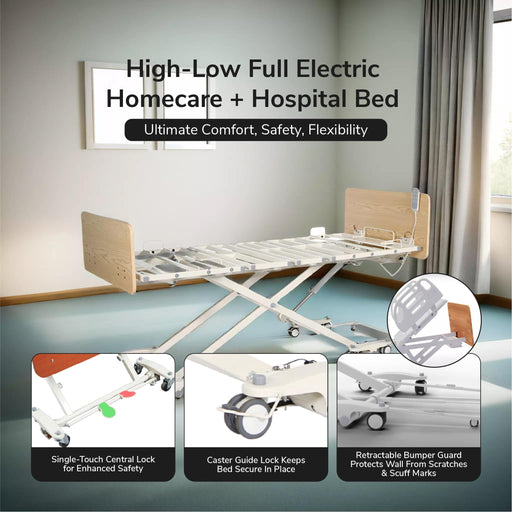
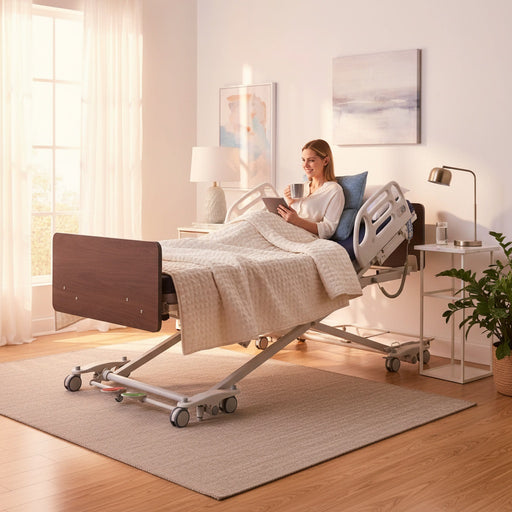
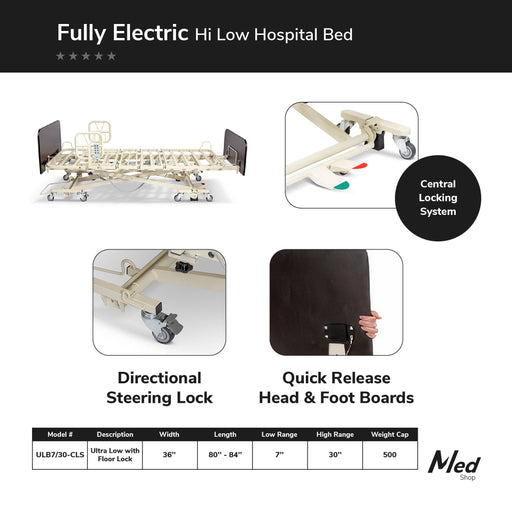
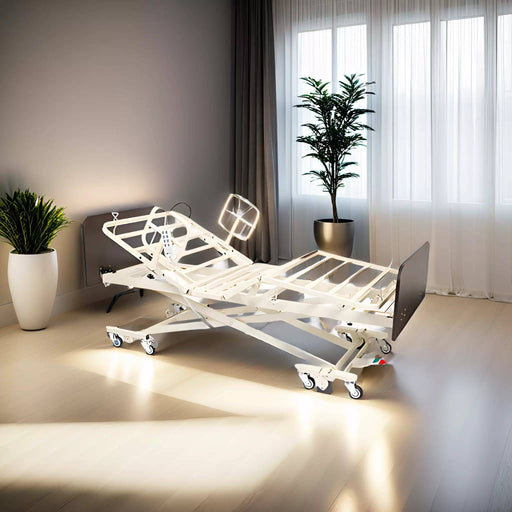


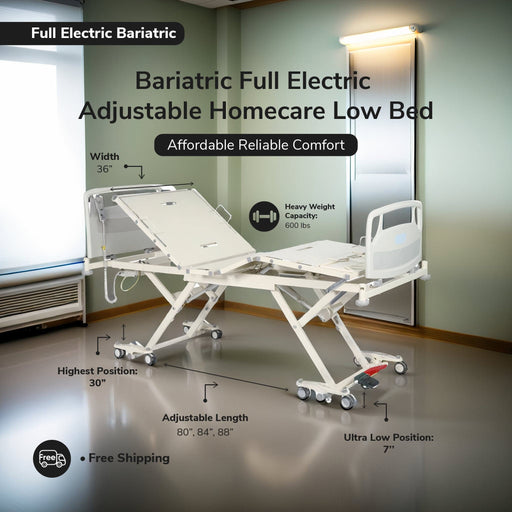
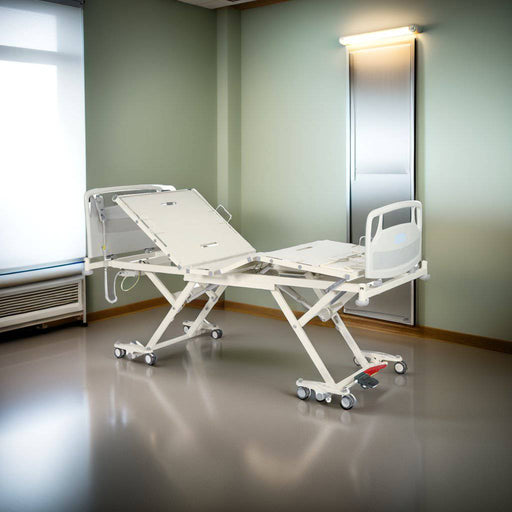
Leave a comment